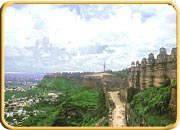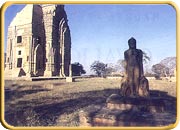Gwalior
Places of Interest in Gwalior
 Gujari
Mahal
Gujari
MahalWithin the fort are some marvels of medieval architecture. The 15th century Gujari Mahal is a monument to the love of Raja Mansingh Tomar for his intrepid Gujar Queen, Mrignayani. The outer structure of Gujari Mahal has survived in an almost total state of preservation; the interior has been converted into Archaeological Museum housing rare antiquities,some of them dating back to the 1st century A.D. Even though many of these have been defaced by the iconoclastic Mughals , their perfection of form has survived the ravages of time. Particularly worth seeing is the statue of Shalbhanjika from Gyraspur, the tree goddess, the epitome of perfection in miniature . The statue is kept in the custody of the museum's curator, and can be seen on request. The Fort
Standing on a steep mass of sandstone, Gwalior Fort dominates the city and is its most significant monument. It has been the scene of momentous events, imprisonment, battles and jauhars . A steep road winds upwards to the fort, flanked by statues of the Jain tirthankaras, carved into the rock face. The magnificent outer walls of the fort still stand, two miles in length and 35 feet high, bearing witness to its reputation for being one of the most invincible forts of India. This imposing structure inspired Emperor Babur to describe it as " the pearl amongst the fortresses of Hind".
Man Mandir Palace
Built between 1486 and 1517 by Raja Mansingh.The tiles that once adorned its exterior have not survived , but at the entrance , traces
 of
these still remain. Within the palace rooms stand bare, stripped of their former
glory, testifying to the passing of the centuries. Vast chambers with fine stone
screens were once the music halls, and behind these screens, the royal ladies
would learn music from the great masters of the day. Below, circular dungeons
housed the state prisoners of the Mughals. Emperor Aurangzeb had his brother
, Murad imprisoned , and later executed here. Close by is Jauhar Pond, where
in the Rajput tradition, the Ranis committed mass sati after their consorts
had been defeated in battle. At Man Mandir Palace, a poignant ambience of those
days of chivalry and heroism still lingers in the silent chambers. A superbly
mounted Son-et-Lumiere here brings it all alive every evening.
of
these still remain. Within the palace rooms stand bare, stripped of their former
glory, testifying to the passing of the centuries. Vast chambers with fine stone
screens were once the music halls, and behind these screens, the royal ladies
would learn music from the great masters of the day. Below, circular dungeons
housed the state prisoners of the Mughals. Emperor Aurangzeb had his brother
, Murad imprisoned , and later executed here. Close by is Jauhar Pond, where
in the Rajput tradition, the Ranis committed mass sati after their consorts
had been defeated in battle. At Man Mandir Palace, a poignant ambience of those
days of chivalry and heroism still lingers in the silent chambers. A superbly
mounted Son-et-Lumiere here brings it all alive every evening.Jai Vilas Palace and Museum
A splendor of a different kind exists in the Jai Vilas Palace, current residence of the Scindia family. Some 25 rooms have been turned into the Jivaji Rao Scindia Museum, and in these rooms , so evocative of a regal lifestyle, the past comes alive. Jai Vilas is an Italianate structure which combines the Tuscan and Corinthian architectural modes. The imposing Darbar Hall has two central chandeliers weighing a couple of tonnes, and hung only after ten elephants had tested the strength of the roof. Ceilings picked out in gilt, heavy draperies and tapestries , fine Persian carpets and antique furniture from France and Italy are the features of these spacious rooms. Eye catching treasures include : a silver train with cutglass wagons which served guests as it chugged around the table on miniature rails; a glass cradle from Italy used for the baby Krishna each Janmashtami, silver dinner services and swords that were once worn by Aurangzeb and Shah Jahan.
Select a holiday with us